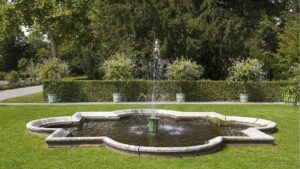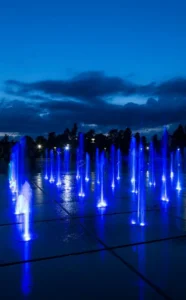- Product Knowledge
Strategic Placement of Fountains
Creating a captivating focal point in landscape design directs the viewer’s gaze and structures the garden’s spatial arrangement. One effective way to achieve this is by placing a fountain. This guide covers how to incorporate fountains into your landscape design, focusing on placement, style, scale, and surrounding elements to create an aesthetic and functional outdoor space.
The Role of Fountains as Focal Points

Fountains serve multiple roles in landscape design. They can be decorative or act as the centerpiece. Their soothing water sounds create a relaxing atmosphere, popular in areas meant for tranquility. Fountains also add humidity, cooling the surroundings during warmer months.
Visual Appeal
Fountains have a strong visual impact. Whether it’s a classic tiered design, a modern sculpture, or a playful splash pad, fountains catch the eye. They add height and depth to a flat landscape and serve as art pieces around which other elements are organized.
Sound and Motion
The sound of water can mask unwanted noises like traffic or neighborhood activity. Water movement adds a dynamic element to a static landscape.
Attracting Wildlife
Fountains attract birds, butterflies, and other wildlife. This brings life to the garden and offers opportunities for natural observation and enjoyment.
Placement Strategies for Maximum Impact
Placing a fountain should be thoughtful and deliberate. Consider various aspects of the landscape and the homeowner’s goals. Here are some strategic considerations:
Entrance Areas
Placing a fountain near the entrance of a home or garden makes a strong first impression. It sets a tone of elegance and hospitality. For formal homes, a classic fountain can enhance the sense of grandeur.
End of a Vista
In larger gardens, a fountain at the end of a pathway or line of sight draws visitors through the space. It creates a beautiful focal point visible from the home or other parts of the garden.
Center of a Circular Drive or Garden
A fountain in the center of a circular driveway or garden layout enhances symmetry and anchors the design.
Secluded Nooks
In smaller, intimate spaces, a small fountain in a secluded corner can create a private retreat area. Surrounded by lush plantings, it transforms an ordinary corner into a tranquil hideaway.
Choosing the Right Fountain Style
The fountain style should match the garden’s theme and the home’s architectural character. Here are a few styles to consider:
Traditional Styles
For classical or formal landscapes, tiered stone fountains or those mimicking historical designs add timelessness and dignity. These often feature intricate carvings and statues, complementing a traditional home’s architectural details.
Modern Designs
In contemporary settings, fountains with clean lines and minimalistic designs work best. Materials like metal or glass and features like sheer descents create a sleek focal point aligning with a modern aesthetic.
Naturalistic Fountains
For natural-looking gardens, fountains incorporating rocks and mimicking waterfalls add to the organic feel. These fountains blend seamlessly into the landscape.
Scale and Proportion
The fountain’s size should match the space it occupies. A large fountain can overwhelm a small garden, while a small fountain might get lost in a vast landscape. Balancing the scale with the space and surrounding elements is crucial.
Large Gardens
In large gardens, a bold, large-scale fountain can be a majestic centerpiece. It is visible and enjoyable from various points and can become a landmark within the space.
Smaller Spaces
In small courtyards or patios, a modest fountain adds charm without dominating the area. Small, self-contained fountains are ideal for these settings, requiring minimal maintenance.
Integrating with Other Landscape Elements
A fountain should integrate with other landscape elements. This includes pathways, lighting, and plantings that enhance it. The choice of plants around a fountain is particularly important.
Plant Selection
Choosing the right plants around the fountain enhances its beauty and integrates it into the garden. Plants with lush foliage or vibrant blooms draw more attention to the water feature.
Lighting
Strategic lighting transforms a fountain’s appearance at night. Submersible lights can illuminate the water, while landscape spotlights can accentuate the fountain’s structure.
Seating Areas
Placing benches or seating areas near the fountain invites visitors to enjoy the soothing sounds and sights. This makes the fountain a visual and social focal point.
Maintenance Considerations
Maintaining an outdoor fountain is crucial for its longevity and functionality. Regular cleaning, checking the pump and water levels, and winterizing are important aspects.
Water Quality
Keeping the water clean prevents algae growth and protects the pump. Using appropriate treatments and regularly replacing the water keeps the fountain in good working condition.
Structural Integrity
Regularly inspecting the fountain for cracks or wear and promptly repairing any damage prevents larger issues. This is especially important in freezing climates.
Strategically placing fountains in landscape design is more than an aesthetic decision. It considers visual appeal, auditory effects, interaction with wildlife, and integration with other garden elements. By thoughtfully selecting the style, scale, and placement of a fountain, you enhance the beauty and functionality of any outdoor space. This makes it a centerpiece of landscape design and a source of joy and tranquility for years to come.



